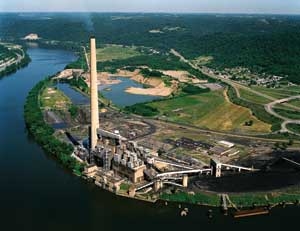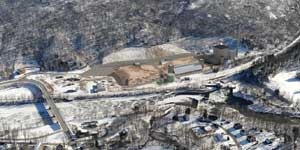
Replacing Coal with BiomassDec 22, 2009 - Jennifer Runyon - renewable-energy-world.com When thinking about retrofitting coal boilers or building biomass power plants from scratch, utilities should consider all of their options. Spurred by renewable portfolio standards, impending carbon legislation and public concerns about the environment, utilities across the U.S. are considering how they might lower emissions and incorporate more renewable energy into their electricity generation mix. And while wind, solar and other types of renewable energy plants remain on the table as options to explore, one choice they may already be familiar with is biomass. If a utility already burns coal, it may be able to convert some or all of its coal-burning plants to biomass plants.
“No
question that the utilities in the U.S. are starting to take a serious look at
this,” said Charlie Niebling, general manager at New
England Wood Pellets, a wood pellets manufacturer. “I think it’s being driven
by the prospect of passage of a carbon cap-and-trade bill that will fall heavily
on the utility electric generation sector,” he said. Converting a coal-fired power plant into one that uses biomass is precisely what First Energy plans to do. Last April the utility announced plans to repower its coal-fired R.E. Burger Plant Units 4 and 5 using biomass. Ultimately, the plan is for the 312 MW plant to be powered by up to 100 percent biomass. However, the plant also is being designed with co-firing up to 20 percent coal. First Energy spokesperson Mark Durbin said the utility is making the switch as a result of a Consent Decree involving the Department of Justice, Environmental Protection Agency and several other parties. “At Burger, we had three choices: install scrubbing equipment, shut it down or repower the plant with another fuel source,” he said. Repowering the plant with biomass seemed like the best option because it would not only help the utility keep jobs but it would also allow the utility to meet some of Ohio’s renewable portfolio standard goals—with a baseload power source to boot. “Biomass power is continuous and not dependent on the sun shining,” said Durbin. “It can be dispatched when you need it.” First Energy subsidiary First Energy Generation Corp. is developing the project, which has a cost in the ballpark of $200 million. Engineers from First Energy traveled to Belgium, Sweden, Denmark and Holland this past spring to visit and learn from existing biomass projects. The system at Les Awirs in Belgium is a retrofitted 80 MW pulverized coal power plant that was converted in 2002 to use biomass as its sole fuel. The utility, Electrabel, uses pelletized recycled forestry/wood waste that is then pulverized before being fed into the power plant’s former pulverized coal boiler. This is a system similar to the one being considered in Ohio. When complete, the Burger plant will be among the largest biomass power plants in the U.S. Since a project of this size hasn’t been done in the United States, challenges do exist, said Durbin. While the company already has in place equipment and systems to monitor particulates and nitrogen oxide emissions, it will need to solve a number of problems before getting the project off the ground. One problem is storage. “Coal can get wet, get snowed on,” said Durbin. By contrast, biomass needs to stay dry. Durbin said the company plans to source biomass much in the same way it sources coal: from the best supplier. That may involve using wood chips and/or waste wood and processing it in a manner similar to the way coal is processed, or it may involve sourcing pellets. It’s also possible the company would use organic material such as switchgrass. “We are still working through the logistics,” said Durbin. What About Heat? For now, First Energy Generation plans to use the biomass to produce electricity alone and not harvest waste heat for cogeneration or combined heat and power (CHP). And that’s a problem, according to Dan Richter, professor of soils and forest ecology at Duke University. “If we burn wood for electricity only, about three to four logs need to be burned to recover the energy contained in one. If heat and electricity are recovered with advanced wood combustion (AWC) technology, we can capture three to four times the energy that is recovered when burning wood solely for electricity,” he said. Richter said AWC technology is widely deployed in Europe with plants achieving up to 90 percent efficiencies from burning biomass. Interestingly, four of the five plants that First Energy Generation engineers visited in Europe are combined heat and power (CHP) plants, even though the Ohio plant will generate electricity only. Richter and a consortium of experts in the forestry and energy industry believe that burning wood solely for electricity wastes sizeable amounts of thermal energy. “When we do calculations on how much wood is available in the nation and we look at potential supplies for energy we find that there’s just not enough of it to waste,” he said. “But if we can use it efficiently — capturing 70, 80, 90 percent [of the embodied energy in wood] — then wood does become a pretty interesting source of renewable energy that the country isn’t really aware of yet.” The group authored an op-ed, Rekindling Wood Energy in America, published on RenewableEnergyWorld.com in June in which they stated, “Wood is widely used for solid-wood and paper products, and is critical to forest biodiversity, water and soil quality, recreation and carbon sequestration. For all these reasons, common sense indicates wood must be used as efficiently as possible.” What’s a Utility to Do? To use AWC, any burning of biomass must capture and use the heat created in the process. Richter points to college campuses, small towns and urban areas across the country that are using this type of technology through CHP systems; in essence, using biomass to generate electricity as well as to heat and cool buildings in a centralized location. Richter said that siting is one of the keys to take advantage of AWC technology. “Siting is so important to be able to technologically capture the heat as well as to ensure supplies of the biomass energy itself,” he said. In other words, people or industries need to be near the system to take advantage of the biomass-generated heat. There also needs to be enough woody biomass nearby to ensure that transportation isn’t an issue. But what about utilities that are converting coal-fired plants that are not sited in such a way so that they could harvest heat? “What they might do is think about developing an industrial park around the plant,” said Richter. Benefits Abound In western Massachusetts another company is preparing to build a wood-fueled power plant. Russell Biomass is proposing a 50 MW plant on the former home of the Westfield River Paper Co. According to Peter Bos, project developer, the Russell Biomass plant will use wood from 40 or 50 different wood suppliers. The suppliers will provide wood chips from untreated wood that comes from land clearing and tree removal, stumps, waste pallets and municipal as well as private woodyards that receive clean waste wood.
Bos said New England has quite a bit of waste wood. While the company has yet to sign a purchased power agreement, it is talking with investor-owned utilities and municipal power companies in Massachusetts and elsewhere in New England. The project is not without opponents, with groups protesting everything from air pollutants to the impact the waste heat will have on salmon populations in nearby rivers. To address this opposition, Bos said the company simply must provide the facts clearly and consistently, again and again. He said this biomass plant is the tightest permitted biomass plant in New England. “If the others are safe — and there are others at schools and hospitals across New England — then ours is the safest.”
With or without CHP, New England Wood Pellet’s Niebling believes we’ll see more utilities looking at biomass power. "Many utilities are probably quietly exploring this option getting ready for what may be coming out of Washington,” he said. “If it’s cost effective to do, I suspect many of them are going to do it.” |
Email this page to a friend



 Like
First Energy’s plant in Ohio, the Russell Biomass plant (pictured left) will not
use CHP technology, instead using biomass to create electricity at an efficiency
rate of 25 percent. The heat won’t be harvested in any kind of district heating
scenario; “it’s just not a good location for that,” said Bos. However, using the
85-degree cooling water that exits the plant to heat a greenhouse is an option
that has been discussed.
Like
First Energy’s plant in Ohio, the Russell Biomass plant (pictured left) will not
use CHP technology, instead using biomass to create electricity at an efficiency
rate of 25 percent. The heat won’t be harvested in any kind of district heating
scenario; “it’s just not a good location for that,” said Bos. However, using the
85-degree cooling water that exits the plant to heat a greenhouse is an option
that has been discussed.